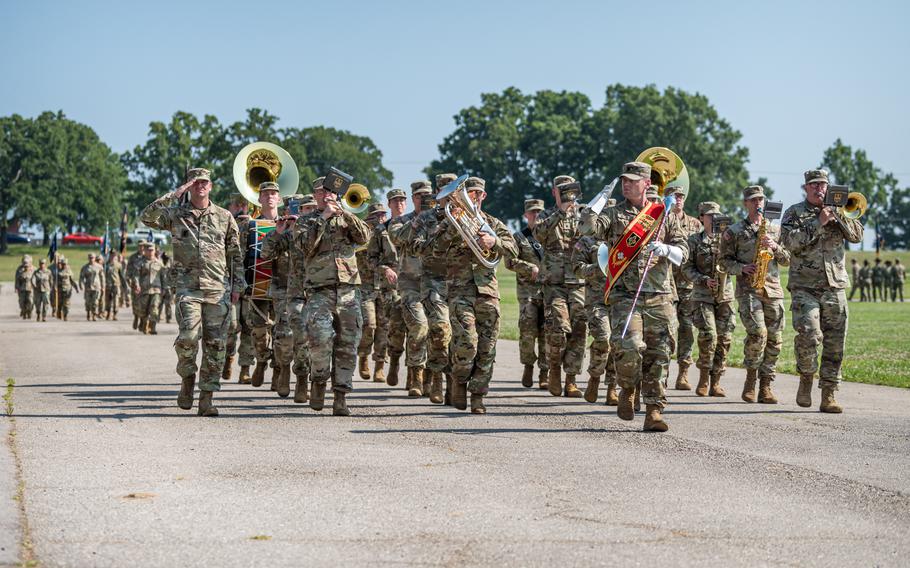
The Army Field Band performs during a ceremony at Fort Leonard Wood, Mo., in June 2023. This month the band will inactivate. (U.S. Army)
The Army is breaking up four of its active-duty bands by the end of this month as the service adjusts what jobs are most needed given its smaller size and the prospect of looming wars.
At four U.S. bases, the bands have spent the past year checking inventory and distributing it to other bands in the Army, National Guard and Reserve while also making certain that every musician is reassigned. Each also hosted one final farewell concert for the community.
The 11th Airborne Division Band in Alaska was inactivated in June, followed by the U.S. Army Japan Band in August. This month, the 399th Army Band at Fort Leonard Wood, Mo., and the 77th Army Band at Fort Sill, Okla., closed operations.
“It’s always sad to the band,” said Lt. Col. Treg Ancelet, commandant of the Army School of Music and chief of Army Bands. “It hits home for a lot of these alumni, even current soldiers, because this is part of their identity, and they have so much pride in that.”
The 164 soldiers affected were reassigned to the other 17 bands that remain in the active-duty Army, many of which were operating below their authorized amount of band members of about 42 soldiers, he said.
Many types of units have been operating with fewer soldiers than authorized because the Army’s roughly 445,000 soldiers have been working within a force structure made for 494,000.
The band closures came from a routine Army analysis meant to realign troops amounts with its five-year goal, the service said. Analysts determined the service needed fewer musicians and more soldiers with jobs that can help fight in a peer-to-peer war, such as air- and missile-defense jobs. It’s part of an ongoing shift from the counterterrorism operations of the wars in Iraq and Afghanistan toward the national security threats from China, Russia and Iran.
Other units that faced restructuring included special operations, cavalry squadrons, infantry brigades and security force assistance brigades.
Challenges in recruiting have also forced tough decisions. The Army lowered its enlistment goal last year, though it pledged this month to increase the number of recruits it brings in this fiscal year, which began Oct. 1, from 55,000 to 61,000. That is still below the Army’s 2023 goal of 65,000, which it failed to meet.
After deciding to reduce the number of musicians and bands in the Army, the service used specific criteria to determine which bands would close operations. The Army said it analyzed each band and location in the previous five years and the populations that the bands were able to reach. These four didn’t have the reach of other bands or could be backfilled by bands in the Army Reserve or National Guard, the Army said.
There are 51 bands in the Army National Guard, and 13 in the Army Reserve, according to the service.
Military bands date to the Revolutionary War, and their heraldry and tradition have a strong hold in the armed forces. During the Civil War, each regiment was required to organize a field band primarily comprised of bugles, fifes and drums. The main purpose of these bands was command and control and to sound off specific movement and operations through music.
Nowadays, Army bands are better known for bringing live music to ceremonies or a morale boost in combat zones. There are 16 different musician billets in the Army to account for different instruments, and soldiers are assigned based on the needs of each band.
Bands also build connections to the civilian communities outside of an installation by participating in festivals and parades or hosting a concert. Last holiday season, the Fort Sill band performed 15 shows in 10 days from Albuquerque, N.M., to eastern Oklahoma, as well as its own concert in nearby Lawton.
“I think a lot of people in the band always enjoy doing those [community] shows, because a lot of people come out,” said 1st Lt. Jaxon Lewandowski, commander of the 77th Army Band at Fort Sill. “The crowds are usually packed. Their reactions just create a feedback loop of positive energy and good vibes.”
At Fort Leonard Wood, musicians have worked to fill the silence they’ll leave behind by recording the songs that are part of a standard Army ceremony, such as “The Army Song” and the national anthem, so commanders can still have the music once they’re gone. The base is home to the Army’s training schools for engineers, chemical soldiers and military police, so the band also recorded training music to keep soldiers marching in step.
“As a training base, we do a lot of the ceremonies for military graduations, whether it’s basic training or officer courses,” said 1st Sgt. Jennifer Champagne, senior noncommissioned officer of the 399th Army Band at Fort Leonard Wood. “It’s a unique opportunity for us to continue that history.”
Just because a band is shut down and its colors cased doesn’t mean it could never return to the Army. The 399th deployed to Germany and Italy during World War II and then shuttered for a few years before returning to duty. Chief Warrant Officer 4 Jared DeLaney served as the band’s commander first in 2009 and then returned a year ago knowing the band would likely inactivate.
“While we’re inactivating four bands this year, it’s still very much a part of the United States Army. It’s integral to connect the soldiers to the past,” he said. “As we fold our guidon, the mission will certainly be carried on by our brothers and sisters.”